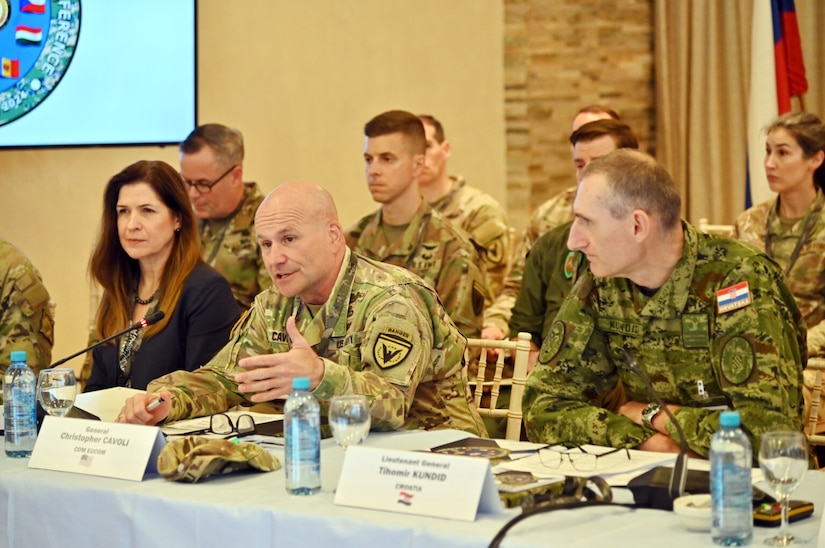The NATO nations face challenges in defending all alliance territory from aggression, said Army Gen. Christopher Cavoli, supreme allied commander Europe and commander of U.S. European Command.
Cavoli spoke at the Aspen Security Forum today and said the NATO alliance is in the midst of a major change in focus and readiness. “There is a lot of work to be done, and there are big challenges looming — some of them are right in our face, right now,” the general said.
That looming threat, of course, is Russia, but Cavoli cannot ignore challenges on the horizon, and that includes China.
The general gave an explanation of the situation in Europe since he became NATO’s combatant commander just after the Madrid Summit in 2022. At that summit, NATO leaders immediately implemented a strategy to deter Russia and to defend the alliance’s territory. “This was an enormous sea change,” Cavoli said. “That was the business we were in during the Cold War, but after the Cold War, it was no longer necessary, and we turned our attention to out-of-area operations.”
Those operations in the Balkans, Kosovo and Afghanistan allowed NATO nations to field smaller forces who would deploy for specific times. “[The deployments] happened on a very predictable basis, which allowed for a cyclical force-generating process that allowed us to take many, many economies everyplace else, except for the unit that was deployed,” he said. “All the nations and NATO happily took the peace dividend and built a force that was optimized for that sort of operation.”
Russia launched its second invasion of its Ukrainian neighbor, and that force-generating process was instantly outdated. NATO had to focus — once again — on collective territorial defense. “We need standing forces, and at standing levels of readiness, geographically focused on specific areas,” Cavoli said. “So, we wrote … operational plans to do this.”
These plans are for northwest Europe, the center of Europe and in southeast Europe, and they are “classical plans that describe how to defend a certain piece of geography, with what forces and what methods,” the general said. “This has led to a huge raft of advances that we’re working on in NATO right now.”
Among the biggest is the need for many more NATO troops ready to fight when needed. This requires money and Cavoli is encouraged by alliance progress in meeting the 2% of gross domestic product that now 23 nations have met.
Since Madrid, the nations also now “have a shopping list for military requirements,” Cavoli said. “That shopping list had been put into place. It has been embraced by nations, who are spending the money to do something about it.”
On the military side, the alliance has also changed command and control, the exercise program the force posture across Europe.
“All of these things are really going to lead us to a healthier alliance that’s focused on the core task of collective territorial defense,” he said.
Supporting Ukraine is vital for U.S. and European security, Cavoli said. But people need to consider what’s next. “We can’t be under any illusions: At the end of a conflict in Ukraine — however, it concludes — we are going to have a very big Russia problem,” the general said. “We are going to have a situation where Russia is reconstituting its force, is located on the borders of NATO, is led by largely the same people as it is right now, is convinced that we’re the adversary, and is very, very angry.”
NATO must continue to support Ukraine now and must prepare for the inevitable end of the war in that country. Americans need to understand that Europeans see Russia’s invasion of Ukraine as an existential threat. “I think it is underappreciated in … the United States, just how much our European allies have awakened to the fact that the house is on fire,” Cavoli said. “This is not a show, and this is not just rhetoric. This is true concern about the stability of their continent, and the survival of their states.”








